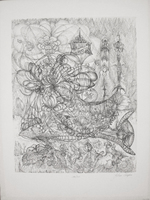Juliana Seraphim
Saint John Perse I
1971
Etching
Sheet: 25 1/2 in. x 19 1/2 in.
Plate: 19 1/2 in. x 15 1/2 in.
Gift of Dr. Samuel Mandel
Juliana Seraphim was born in Jaffa in 1934, and was among one of the first waves of displaced Palestinian refugees to move to Beirut, Lebanon in 1952.1 She was 14 when her family fled first to Sidon by boat in 1949, it was after their move to Beirut that she then worked in refugee relief while attending art classes.2 It was in Beirut that Seraphim produced her most notable works and developed her personal style. After studying at the Lebanese Fine Arts Academy as well as privately with other local contemporary artists, she began to show her work in solo exhibitions and gained recognition within Beirut.3 She privately studied with Lebanese painter Jean Khalifeh (1923-78) and her first exhibitions took place in his studio.4 She then went on to internationally represent Lebanon in three biennials - Alexandria (1962), Paris (1963), and Sao Paolo (1965).5 Whereas her Lebanese contemporaries tend to take on a figurative style in order to demonstrate the central issues of the Palestinian struggle, Seraphim’s visual language is often characterized as having complex layers of overlapping lines and improvisational dream-like imagery.6
Within her etching Saint John Perse I, in the collection of the college, a large fish horizontally divides the composition, however the fish blends seamlessly into overlapping flora, long-feathered birds, and human faces. The density of the line-work and her use of layering imagery creates an immersive world for the viewer to visually explore. In Saint John Perse I form begets form, the longer we look at a seemingly simple flower the more we see smaller leaves, berries, butterflies and human forms within and then even further within those. The tone of the imagery also varies with thick spider-web tangles and insect-thin contorted human forms residing in the complex visual scene presented. The use of black and white rather than color makes differentiating form from form difficult for the viewer; it requires active participation from the viewer to lean into the work and begin parsing out line from line and discovering the layers of imagery embedded within the work. Furthermore, the title of this work makes reference to the poet born in Guadeloupe, Saint John Perse, who won the Nobel Prize in Literature in 1960.7
When asked, Seraphim cites the source of her surrealist imagery as memories of her childhood. She drew specific inspiration from the faded frescoes of winged beings on the ceiling of her grandfather's home, and former convent, in Jerusalem.8 In this way, Seraphim cultivates a shifting reality of infinite depth and creation. Her dream-like imagery also implies the unsteady nature of a long-held memory of a cherished place - and in doing so she transcribes her political concerns regarding her home through the lens of personal and surreal imagery while also encouraging the viewer to actively participate with the imagery presented.
1. Kamal Boullata, “The World, the Self, and the Body: Pioneering Women in Palestinian Art,” Hagar Art Gallery, 175. Accessed Oct 10, 2016. http://www.hagar-gallery.com/Catalogues/Self_Portrait_02_01.pdf
2. Kamal Boullata, “Art” in Phillip Mattar, Encyclopedia of the Palestinians. (New York: Maps - Facts on File), 84.
3. Boullata, “The World, the Self, and the Body”, 175.
4. Kamal Boullata, “Artists Re-Member Palestine in Beirut,” Journal of Palestinian Studies 32, no. 4 (2003), 33.
5. “Juliana Seraphim,” Art in Lebanon, 2007. Accessed Oct 10, 2016. http://www.artinleba
non.com/artists/juliana.html
6. Boullata, “Pioneering Women in Palestinian Art,” 175.
7. “Saint-John Perse - Biographical,” Nobel Prize, 2014. Accessed October 24, 2016. http://www.nobelprize.org/nobel_prizes/literature/laureates/1960/perse-bio.html
8. Boullata, “Artists Re-Member Palestine in Beirut”, 34.
-Emily Smith

